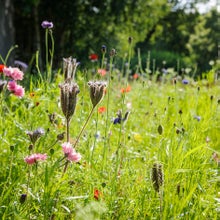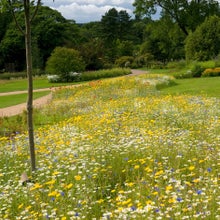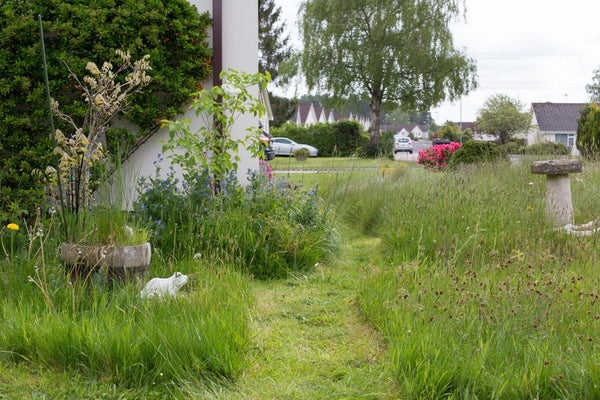
Quick facts
Grassy places wildlife finds a home;
Bumblebees forage for nectar on lawns where clover and other lawn ‘weeds’ are allowed to flower
Short grass lets green woodpeckers hunt for ants and some solitary bees find nesting spots
Long grass creates a mini-jungle for grasshoppers and many other invertebrates
A mini-meadow offers seedheads for finches
Lawns
The British love their lawns. The perfect emerald-green, velvet-smooth sward is a thing of envy, especially in parts of the world where the climate isn’t quite so lawn-friendly. But it takes much time and energy to achieve such a standard, not to mention lots of water.
There is another factor to consider: a tightly-clipped, weed-free lawn isn’t particularly wildlife-friendly. A fine ornamental lawn is likely to contain only three or so types of grass which limits the variety of creatures it can support. Blackbirds might use it to hunt for worms but the scope for wildlife is limited.
However, there’s no need to replace your lawn if you want to make your garden more attractive to wildlife. Simple steps, such as reducing mowing frequency and stopping feeding will all help.
Put away the weedkillers and fertilisers

Lawn weedkillers and fertilisers are designed to eliminate any plant that is not a grass and to boost the growth and greenness of the lawn grasses. Stopping using them won’t mean your lawn becomes immediately brown or unsightly, but it will at least give the flowering plants a chance, meaning they can provide nectar and pollen for bees and other pollinating insects. Dandelions, for example, are an excellent early source of pollen for flies, bumblebees and solitary bees, flowering even in the winter months.
It's also not a bad idea to reduce unnecessary input of (which includes weedkillers) and fertiliser in a garden, many of which may have hidden environmental costs either in their use or manufacture.
Give the mower a rest

Just setting the mower on a higher cut might be sufficient to allow a few low-growing daisies and dandelions to flower. Leaving the grass a little longer also provides extra protection from the sun and so helps make the lawn more resilient during a drought.
Or step it up a notch by reducing the mowing frequency. Experiment with mowing on a 3, 4 or 6 week cycle to give lawn flowers such as speedwell, selfheal and buttercup time to bloom. Bees are especially fond of clover.
Another approach is to simply stop mowing altogether between March and the end of August. Many grasses are food plants for a wide range of invertebrates including the caterpillars of butterflies and moths so this will give them chance to lay eggs and complete their life cycle. Butterflies you might attract include the skippers, meadow brown, speckled wood, gatekeeper, ringlet and small heath. If the grass growth is very lush you may need to mow once or twice in the summer but try to keep at least one patch unmown to avoid disturbing any hungry caterpillars.
Top Tip
Leave a 1m x 1m square of lawn uncut for a summer. Involve the whole family to record how many different plants and creatures you spot – you might be surprised.
Add in some wildflowers
If your lawn doesn’t seem to contain many ‘weeds’ or you fancy adding some more wildflowers, sow seed under cover in early spring in seed trays and when they are big enough, plant them out into the lawn. Alternatively, plant plugs which can be sourced from nurseries. Spring flowering such as fritillaries, or crocus can be planted in autumn. Cut the grass short first to help the plants or bulbs establish. Scattering wildflower seed onto an area of grass doesn’t usually work.
Attractive wild flowers for short turf;
Lotus corniculatus (bird’s-foot trefoil)
Euphrasia (eyebright)
Prunella vulgaris (self heal)
Viola (violets)
Thymus polytrichus (wild thyme)
And for long grass left uncut for most of the summer;
Succisa pratensis (devil’s-bit scabious)
Knautia arvensis (field scabious)
Eupatorium cannabinum (hemp agrimony)
Heracleum sphondylium (hogweed)
Centaurea (knapweeds)
Malva sylvestris (mallow)
Dipsacus fullonum (teasel)
Origanum vulgare (wild marjoram)
Wildlife-friendly tips for your lawn or long grassed area
- To get the most out of your flower-rich lawn, mow it short between September and the end of February, removing the clippings
- If you are only mowing your grassed area once in summer, do this in late summer or after the majority of flowers have set seed
- A lawn that hasn’t been fed will benefit from an annual maintenance programme of scarifying and . See our page on autumn lawn care
- Any newly grassed area needs regular mowing in its first year to give it a chance to establish
- When mowing or strimming long grass, take care that any hedgehogs, toads, grass snakes and other creatures won’t be harmed by first walking over the area in a noisy, heavy way (dance and jump around if you like!)
Meadows and mini-meadows
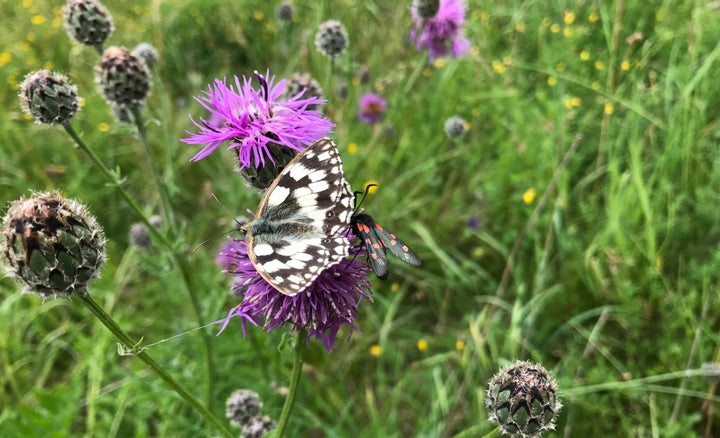
hay meadows have declined dramatically in the British countryside and their loss has been bad news for the many species of plants and animals associated with them. Meadows are a special habitat, important for a great variety of insects and small rodents along with birds such as flycatchers, larks, thrushes, finches and birds of prey.
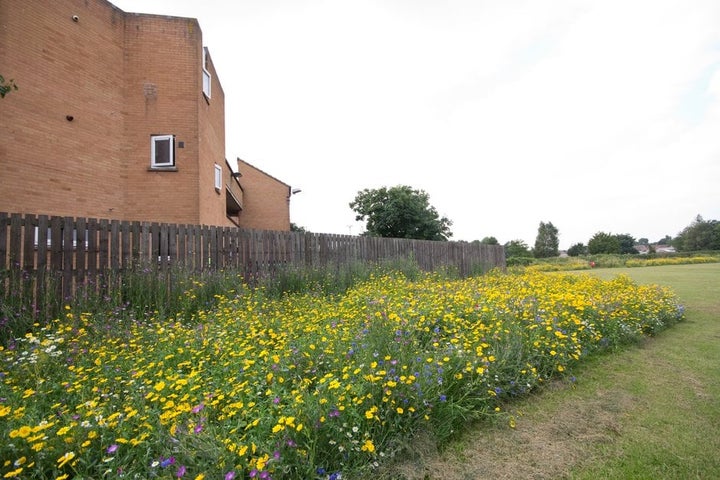
Flower-rich arable land where a mix of wildflowers known as cornfield – such as cornflower, corncockle, field poppy and corn marigold – grow among the crop are also valuable sources of nectar and pollen for flying insects and seed too for birds. These are an equally rare sight in the countryside, though some farmland schemes are helping to reintroduce them.
Whatever size your garden, there’s an opportunity for a small wildflower patch. You can set aside an area of lawn or part of a border or even a large container on the patio. Decide whether you want to grow annuals (which are often very colourful but need sowing fresh every year) or (a true meadow is made up of grasses and wildflowers). It’s quite fun to at least start with annuals, especially if your soil is fertile.
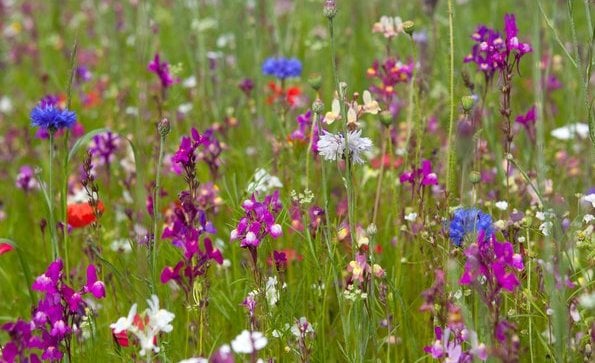
Look out for mixes advertised as being particularly good for certain wildlife such as birds or butterflies. You’ll also want to think about whether to opt for British wildflowers or ornamental mixes, which include non- flowers. Terms can be confusing when it comes to wildflowers so you can learn more here.
Have a go
Follow our step-by-step on growing a mini-meadow.
For lots more on how to get your meadow started and how to take care of your wildflower meadow see our RHS Guides below.
Suggested plants
Take a walk on the wild side with these five colourful wildflowers. Or try some listed below.
Centaurea nigra (common or lesser knapweed)
Rhinanthus minor (yellow rattle)
Leucanthemum vulgare (ox-eye daisy)
Knautia arvensis (field scabious)
Campanula rotundifolia (harebell, Scottish bluebell)
Dactylis glomerata (cocksfoot)
Festuca ovina (sheep's fescue)
Holcus lanatus (Yorkshire fog)
Wildlife-friendly tips for your meadow or mini-meadow
- Try to choose a plant mix suited to your soil conditions as this will mean the plants will do better. Most plants will be happiest in an open, sunny spot but some mixes suitable for sowing along hedgerows or in woodland edges will have some shade tolerance
- Wildflowers are available in plug form and in ready-planted turf rolls which can make establishing the plants even easier
- If using , leave the old stems uncut through winter to provide cover for invertebrates and allow birds to pick clean of seeds. Pull out the dead plants in February ready for sowing again
- meadows are usually cut in early summer (the ‘hay’ cut) which helps stop the grasses becoming too dominant. But if you can, aim to leave at least one section of the meadow uncut for the whole summer to help caterpillars feeding on the grasses
- As when mowing long grass be vigilant when cutting back your meadow – small mammals, amphibians and reptiles may be hiding there. Some birds nest in larger meadows so as a precaution don’t mow until after the beginning of August
- Keep a look out for a meadow specialist, the scabious bee (Andrena hattorfiana), a type of mining bee which gathers pink pollen from field scabious (Knautia arvensis) and carries it in hairs on their hind legs
